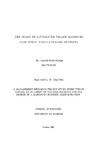| dc.description.abstract | In the Banking Industry, Information Technology has brought about the automation of
many banking services over the years. An ATM is a device used by Bank customers to
process Bank account transactions. ATMs have become an important service delivery
channel for Banks. To better understand usage on the ATMs, the study brings out the
dependencies that ensure successful customer transactions at the ATM. The study also
looks into the interaction between customers and systems and how to address service
failure.
The main objective of this exploratory study was to identify the factors that affect the
usage of ATMs. Judgmental sampling was used in this study and 100 questionnaire were
administered to respondents within Nairobi City Center. The study targeted users of
Barclays ATMs to complete the questionnaire. The data was analysed using SPSS
Computer Package.
In summary the results indicated an overwhelming preference for the ATM against the
choice of using Bank Cashier to make cash withdrawal. The results further indicated that
the factors that affect the usage of ATMs includes the presence of a guard at ATM
location, the preference for ATMs located at a Bank Branch, the measures taken to ensure
sufficient security at ATM location, the reliability of ATM to provide services, the length
of the queue at the ATM, the cleanliness of the ATM location, sufficient lighting at the
ATM location, the choice of the ATM location aligned to customer preferences, the
surveillance camera deployed at ATM locations and ATM located within a lobby
(enclosed area) are preferred.
Banks and Financial Institution need to ensure they implement the factors that affect the
usage of ATMs by reviewing each ATM location before and after installation, to ensure
they realize the maximum benefit from their investments. An understanding of customer
needs and expectations with regard to ATM services is critical for the success of ATM
services for the organisation.
Research has often demonstrated that responding to customer needs and resolving
customer problems effectively has a strong impact on customer satisfaction, loyalty and
bottom line performance. | en |

